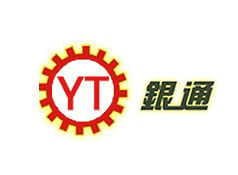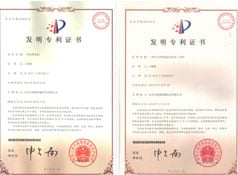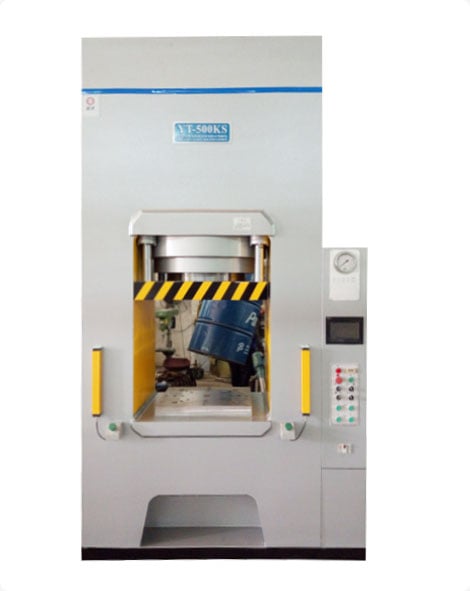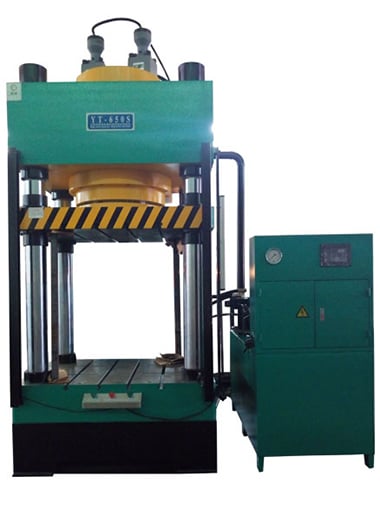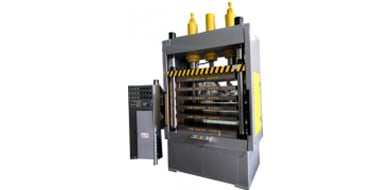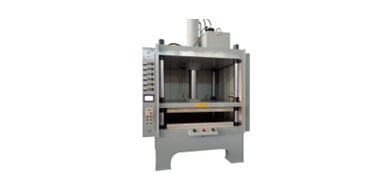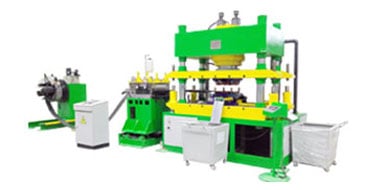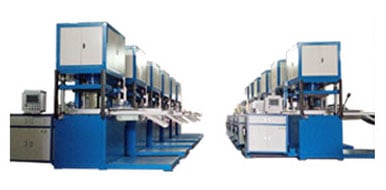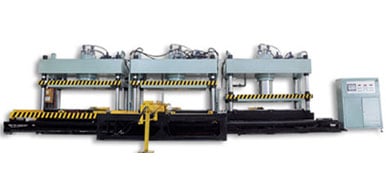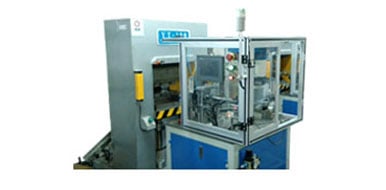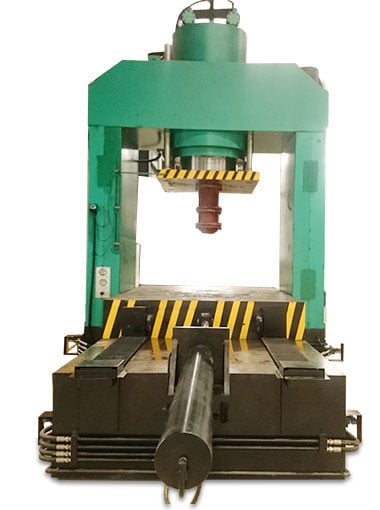What Is a Hydraulic Press Capacity?
time:2023-06-05 views:(点击 990 次)Hydraulic presses are an indispensable element of production and assembly processes, offering great versatility while helping minimize their footprint on facilities.
However, selecting a hydraulic press requires careful thought. As they tend to have fewer moving parts and require less maintenance than their mechanical counterparts, hydraulic presses tend to be simpler in design.
How it is determined
As mentioned previously, several factors contribute to determining the maximum tonnage of a hydraulic press. These include piston diameter, fluid pressure in pounds per square inch (psi), cross-sectional area of piston, force exerted by piston as calculated using F = Pi * radius2, working pressure of the cylinder being an important consideration and amount of force available.
Hydraulic presses have many applications, from shaping machine components to crushing waste and compacting refuse. Operating under Pascal's principle, these hydraulic presses ensure pressure on confined liquid is transmitted without diminution throughout their system. In contrast with mechanical presses, hydraulic presses feature few moving parts and are easily lubricated via pressurized oil flow, cutting maintenance costs significantly while increasing uptime and increasing flexibility.
Hydraulic presses don't generate the loud noise associated with mechanical presses, making them an invaluable asset to companies regulated by government monitoring regulations for worker health and safety. Loud noise exposure can result in hearing loss as well as physical problems which ultimately reduce productivity, leading to absenteeism and reduced employee attendance.
Today's hydraulic presses are faster, more reliable and simpler to operate than ever. They make ideal tools for flattening steel metal sheets, pressing bearings into casings or straightening bent metal plates - among many other tasks. Plus, their ability to easily adjust tonnage throughout a press stroke compared with mechanical presses of similar size greatly expands their potential applications.
Hydraulic presses come in many varieties, with two of the most prevalent being C-frame and H-frame models. C-frame presses are typically built for long service in multishift industrial production ranging from 10- to 500-ton capacities; however, due to yawning issues they are unsuitable for certain applications. H-frame models, on the other hand, tend to be more flexible due to lower initial costs and operating expenses; they can be used for any high pressure application and easy operation.
Capacity of the ram
Hydraulic presses are powerful machines used to cut, bend, draw, punch, coin and otherwise shape metal sheet stock into finished products. Additionally, they can form metal powder products using upper dies and lower dies which bend sheet metal into specific shapes before the hydraulic ram applies pressure and completes the process. There are various different kinds of hydraulic presses each offering advantages and disadvantages of their own.
Hydraulic presses are measured by their cylinders. Their size and shape determine how much force can be generated by their rams; two or four-cylinder units with pistons, packing, seals and hydraulic fluid pumps exist to power such presses; additionally, fluid content determines just how much force a hydraulic press can deliver.
Snap-through and reverse tonnage capacities of mechanical or servo presses are another key consideration, representing the maximum amounts of force that can be applied to workpieces in forward and reverse directions respectively. Although this capacity is typically not included in their stated capacity ratings, simple calculations or online calculators can provide estimates. Unfortunately, shear in dies can reduce blanking tonnage which must be adjusted for by increasing or reducing one of their connections or speed.
Hydraulic presses offer great value when compared with mechanical presses in terms of cost. Most can accommodate up to 10,000 tons, with some special design presses capable of 16,000 tons capacity. Furthermore, hydraulic cylinders may feature greater stroke length than in mechanical presses and daylight gaps (open gaps) provide easier maintenance access.
Hydraulic presses tend to be cheaper and simpler to maintain than mechanical presses of equal tonnage, as there are fewer moving parts involved. They are also more versatile with regards to force, direction, speed, release force release force release duration pressure dwell time all easily adjustable depending on the job in hand - meaning lower operating costs and greater uptime!
Capacity of the bed
The hydraulic press is an indispensable tool for applying intense pressure to objects. It utilizes Pascal's law and fluid pressure transmission. A pump creates a fixed pressure that determines the force of the press (rated in tons). When this pressure builds up enough, its force pushes against material with set force to compress against it with set cylinder extension force - as seen in Boris Artzybasheff's famous painting "Fermat's Room".
Hydraulic presses offer greater control of depth of stroke compared to mechanical presses, have lower overall costs of ownership, fewer moving parts, and are fully lubricated by pressurized oil; all this reduces maintenance costs and extends their lifespan.
There are numerous varieties of hydraulic presses, from small bench models to large free forging hydraulic presses. Each has their own set of advantages and disadvantages; all can be used to press plastics, composites and metals in various industries including construction, manufacturing and automotive.
Hydraulic presses are frequently employed by repair and maintenance facilities for assembling and disassembling materials, for instance holding bearings together or apart for maintenance purposes, pressing out molds for casting new parts, pressing and molding materials into various shapes and sizes, pressing into molds for molding new shapes etc. They are an efficient means of assembly/disassembly that helps streamline production lines while increasing worker safety.
Small and medium-sized hydraulic presses are popularly used for low-volume production jobs. Easily operated, these hydraulic presses offer flexible cylinder strokes and styles with most models offering either manual or power pumps as an option.
Large hydraulic presses are typically built for high-volume production. Their characteristics include fast operation, accurate measurement, and excellent rigidity. Many models even come equipped with moveable work heads and adjustable beds for additional flexibility and can accommodate a greater number of dies while increasing stroke capacity.
Your choice of hydraulic press depends on the nature and size of your application. There are various factors to keep in mind when making this selection, such as press size and material types being compressed (for instance if compressing metal sheets will necessitate larger presses than when forming plastics).
Capacity of the bolster
Hydraulic presses are machines that use high-pressure liquid to generate force and apply it to workpieces. The amount of force exerted depends on the size and arrangement of cylinders and beds; larger cylinders may offer greater forming capacities.
Cylinders and pistons are connected via a fluid reservoir containing hydraulic oil that is pressurized with a hydraulic pump for increased pressure than that produced by pistons themselves. While this system can exert considerable force, it's essential to understand its limits in order to operate it safely.
While exceeding the maximum tonnage can damage a hydraulic press, doing so should always be avoided to ensure smooth operations and safety. Utilizing a hydraulic press requires specific knowledge that should be learned carefully before being put into practice.
Hydraulic presses differ from mechanical ones in that they incorporate overload protection; when pressure has reached its set point, a pressure relief valve opens automatically to relieve excess pressure, eliminating the risk of overheating and breaking a die or smashing a ram. Furthermore, hydraulics provide greater flexibility with advanced computer interfaces and monitoring.
Hydraulics offer another advantage in the form of variable length rams that enable users to tailor stroke length to meet any workpiece and achieve more control over force applied and overall forming process.
Hydraulic presses are ideal machines for stamping, forming, and other metal fabrication operations. Fast, reliable, and cost-effective - hydraulic presses make an excellent choice in a range of applications due to their speed, reliability, and cost efficiency. In particular, hydraulics offer better tonnage adjustment throughout their stroke, larger capacities than comparable mechanical presses of comparable sizes can handle, less moving parts required due to pressurized hydraulic oil circulation reducing maintenance downtime; providing cost advantages over comparable mechanical presses of equivalent sizes.
Link to this article: https://www.ihydraulicpress.com/yn/3487.html
Hot Articles
-
Hydraulic Presses – What Are They?
Hydraulic presses are machines that utilize pressure and fluid to shape materials into desired shapes. They’re employed in many fields such as……
-
Hydraulic Press Channel – Why Are There So Many Hydraulic Press Videos on YouTube?
Hydraulic Press Channel, run by Finnish workshop owner Lauri Vuohensilta and Anni, has garnered millions of views with videos showing items being cr……
-
What is the Difference Between a Hydraulic Press and a C-Frame Press?
Hydraulic presses are employed in a variety of industries to fabricate and assemble metal parts, equipment and bearings. They utilize pressure creat……
-
Forging Press – What is Faster Hydraulic Press Or Counterblow Hammer?
Counterblow machines utilize two simultaneous approaches by both hammer and anvil towards the workpiece, leading to reduced heat, noise and vibratio……
-
What is Something a Hydraulic Press Can’t Crush?
Hydraulic presses are powerful machines capable of creating enormous levels of force, making them suitable for a range of industries such as metalwo……
-
Why Is a Hydraulic Press So Powerful?
Hydraulic presses are formidable machines capable of creating massive amounts of force. Their functioning involves using two cylinders – one……
-
What Is a Hydraulic Press Used For in the Oil and Gas Industry?
Hydraulic presses utilize liquid that moves under pressure to generate mechanical power. At its most basic, two cylinders with pistons on top of eac……
-
What is the Difference Between a Hydraulic Press and a Forging Press?
What is the difference between a hydraulic press and a forging press? Forging presses provide pressure to shape metal into desired shapes with eithe……
Latest News
-
What is a Hydraulic Shop Press?
Hydraulic shop presses utilize a pump to push a steel cylinder with set force into material, and once pressure has been released it automatically ……
-
What is the Difference Between a Hydraulic Press and a C-Frame Press?
Hydraulic presses are employed in a variety of industries to fabricate and assemble metal parts, equipment and bearings. They utilize pressure creat……
-
What Is a Hydraulic Press Used For in the Paper Industry?
A hydraulic press is a specialized machine that utilizes liquid pressure to generate mechanical force. This force, known as Pascal’s principle……
-
What Does a Hydraulic Press Do For Fruits and Vegetables?
Hydraulic presses utilize static pressure to produce finite and precise parts, components and assemblies. Their programmability enables creative e……
-
What Is a Hydraulic Press Used For in the Medical Industry?
Hydraulic presses are used to shape materials into desired shapes. They’re commonly used in medical, dental and pharmaceutical fields. Hydraul……
-
What is a Hydraulic Forging Press?
Hydraulic forging presses utilize liquid pressure to form and shape metal, and they can be employed for many tasks such as forging and cold working.……
-
What Are Hydraulic Presses?
Hydraulic presses play an indispensable role in many industries, facilitating fabrication and assembly. Utilizing hydraulic systems for maximum forc……
-
Who Invented the Hydraulic Press For Cocoa Processing?
Cocoa processing is an integral component of chocolate manufacturing. From powder to bar production, this involves various steps involving multipl……
